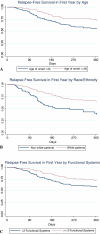Clinical predictors of early second event in patients with clinically isolated syndrome
- PMID: 19252775
- PMCID: PMC2708331
- DOI: 10.1007/s00415-009-5063-0
Clinical predictors of early second event in patients with clinically isolated syndrome
Abstract
This study aimed to determine the predictors of increased risk of a second demyelinating event within the first year of an initial demyelinating event (IDE) suggestive of early multiple sclerosis (MS). Patients with MS or clinically isolated syndrome (CIS) seen at the UCSF MS Center within one year of the IDE were studied. Univariate and multivariate Cox models were used to analyze predictors of having a second event within 1 year of the IDE. Of 330 patients with MS/CIS, 111 had a second event within 1 year. Non-white race/ethnicity (HR = 2.39, 95% CI [1.58, 3.60], p < 0.0001) and younger age (HR for each 10-year decrease in age = 1.51, 95% CI [1.28, 1.80], p < 0.0001) were strongly associated with an increased risk of having a second event within one year of onset. Having a lower number of functional systems affected by the IDE was also associated with an increased risk of early second event (HR for every one less FS involved = 1.31, 95% CI [1.06, 1.61], p = 0.011). These results were similar after adjusting for treatment of the IDE with steroids and disease-modifying therapy. Non-white race/ethnicity, younger age, and a lower number of FS affected by the IDE are associated with a substantially increased hazard ratio for a second demyelinating event within 1 year. Since early relapse is predictive of worse long-term outcome, identifying and treating such patients after the IDE may be of benefit to them.
Figures
Similar articles
-
Demyelinating events in early multiple sclerosis have inherent severity and recovery.Neurology. 2009 Feb 17;72(7):602-8. doi: 10.1212/01.wnl.0000342458.39625.91. Neurology. 2009. PMID: 19221292 Free PMC article.
-
Are initial demyelinating event recovery and time to second event under differential control?Neurology. 2006 Sep 12;67(5):809-13. doi: 10.1212/01.wnl.0000234031.30756.a0. Neurology. 2006. PMID: 16966542
-
Relapse severity and recovery in early pediatric multiple sclerosis.Mult Scler. 2012 Jul;18(7):1008-12. doi: 10.1177/1352458511431725. Epub 2011 Dec 19. Mult Scler. 2012. PMID: 22183939
-
Clinically isolated syndromes: predicting and delaying multiple sclerosis.Neurology. 2007 Jun 12;68(24 Suppl 4):S12-5. doi: 10.1212/01.wnl.0000277704.56189.85. Neurology. 2007. PMID: 17562845 Review.
-
Treatment with disease-modifying drugs for people with a first clinical attack suggestive of multiple sclerosis.Cochrane Database Syst Rev. 2017 Apr 25;4(4):CD012200. doi: 10.1002/14651858.CD012200.pub2. Cochrane Database Syst Rev. 2017. PMID: 28440858 Free PMC article. Review.
Cited by
-
Adaptive and Innate Immunity Are Key Drivers of Age at Onset of Multiple Sclerosis.Neurol Genet. 2024 May 29;10(3):e200159. doi: 10.1212/NXG.0000000000200159. eCollection 2024 Jun. Neurol Genet. 2024. PMID: 38817245 Free PMC article.
-
Do magnetic resonance imaging features differ between persons with multiple sclerosis of various races and ethnicities?Front Neurol. 2023 Jun 28;14:1215774. doi: 10.3389/fneur.2023.1215774. eCollection 2023. Front Neurol. 2023. PMID: 37448745 Free PMC article. Review.
-
Clinical Parameters to Predict Future Clinical Disease Activity After Treatment Change to Higher-Dose Subcutaneous Interferon Beta-1a From Other Platform Injectables in Patients With Relapsing-Remitting Multiple Sclerosis.Front Neurol. 2020 Sep 2;11:944. doi: 10.3389/fneur.2020.00944. eCollection 2020. Front Neurol. 2020. PMID: 32982947 Free PMC article.
-
Predicting onset of secondary-progressive multiple sclerosis using genetic and non-genetic factors.J Neurol. 2020 Aug;267(8):2328-2339. doi: 10.1007/s00415-020-09850-z. Epub 2020 Apr 24. J Neurol. 2020. PMID: 32333165
-
Factors Involved in Relapse of Multiple Sclerosis.J Microsc Ultrastruct. 2019 Jul-Sep;7(3):103-108. doi: 10.4103/JMAU.JMAU_59_18. J Microsc Ultrastruct. 2019. PMID: 31548920 Free PMC article. Review.
References
-
- {'text': '', 'ref_index': 1, 'ids': [{'type': 'DOI', 'value': '10.1002/ana.20703', 'is_inner': False, 'url': 'https://doi.org/10.1002/ana.20703'}, {'type': 'PubMed', 'value': '16283615', 'is_inner': True, 'url': 'https://pubmed.ncbi.nlm.nih.gov/16283615/'}]}
- Polman CH, Reingold SG, Edan G et al (2005) Diagnostic criteria for multiple sclerosis: 2005 revisions to the “McDonald criteria”. Ann Neurol 58:840–846 - PubMed
-
- {'text': '', 'ref_index': 1, 'ids': [{'type': 'DOI', 'value': '10.1001/archneur.63.4.614', 'is_inner': False, 'url': 'https://doi.org/10.1001/archneur.63.4.614'}, {'type': 'PubMed', 'value': '16606781', 'is_inner': True, 'url': 'https://pubmed.ncbi.nlm.nih.gov/16606781/'}]}
- Frohman E, Havrdova E, Lublin F et al (2006) Most patients with multiple sclerosis or clinically isolated demyelinating syndrome should be treated at time of diagnosis. Arch Neurol 63:614–619 - PubMed
-
- {'text': '', 'ref_index': 1, 'ids': [{'type': 'DOI', 'value': '10.1111/j.1468-1331.2007.01810.x', 'is_inner': False, 'url': 'https://doi.org/10.1111/j.1468-1331.2007.01810.x'}, {'type': 'PubMed', 'value': '17662009', 'is_inner': True, 'url': 'https://pubmed.ncbi.nlm.nih.gov/17662009/'}]}
- Ramsaransing GSM, DeKeyser J (2007) Predictive value of clinical characteristics for “benign” multiple sclerosis. Eur J Neurol 14:885–889 - PubMed
-
- {'text': '', 'ref_index': 1, 'ids': [{'type': 'DOI', 'value': '10.1212/01.wnl.0000187122.71735.1f', 'is_inner': False, 'url': 'https://doi.org/10.1212/01.wnl.0000187122.71735.1f'}, {'type': 'PubMed', 'value': '16344520', 'is_inner': True, 'url': 'https://pubmed.ncbi.nlm.nih.gov/16344520/'}]}
- Held U, Heigenhauser L, Shang C et al (2005) Predictors of relapse rate in MS clinical trials. Neurology 65:1769–1773 - PubMed
-
- {'text': '', 'ref_index': 1, 'ids': [{'type': 'DOI', 'value': '10.1007/s00415-008-0743-8', 'is_inner': False, 'url': 'https://doi.org/10.1007/s00415-008-0743-8'}, {'type': 'PubMed', 'value': '18204919', 'is_inner': True, 'url': 'https://pubmed.ncbi.nlm.nih.gov/18204919/'}]}
- Hirst C, Ingram G, Pearson O et al (2008) Contribution of relapses to disability in multiple sclerosis. J Neurology 255:280–287 - PubMed
Publication types
MeSH terms
Substances
Grants and funding
LinkOut - more resources
Full Text Sources
Medical



